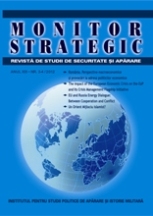First Steps towards Security Scenario Planning in the Geopolitical Area from the Baltic Sea to the Wider Black Sea (2025-2030)
First Steps towards Security Scenario Planning in the Geopolitical Area from the Baltic Sea to the Wider Black Sea (2025-2030)
Author(s): George Vlad NiculescuSubject(s): International relations/trade, Security and defense, Policy, planning, forecast and speculation, Present Times (2010 - today), Geopolitics
Published by: Editura Militară
Keywords: Eastern Europe; neighborhood; strategy; planning; cooperation; Russia; defence; NATO;
Summary/Abstract: The main goal of this research has been to combine past-focused geopolitical analysis with future-focused scenario planning to enhance the foresight of interested political, and business leaders on the evolving regional security environment in the area from the Baltic Sea to the Wider Black Sea (Inter-marium) over the next 10-15 years. The Ukrainian crisis, started in December 2013, signaled the beginning of a new stage defined by the predominance of the geopolitical confrontation between the West and Russia. This research will investigate the nature, potential outcomes, and the drivers of change of the current confrontation between the West and Russia in the Inter-marium, as well as its strategic implications for 2025-2030. From a methodological perspective, this research aims to pave the way to combining classical geopolitical analysis and scenario planning. In practical terms, this research may consider at least four geopolitical scenarios for 2025-2030 that would also serve as research hypotheses: 1. An Inter-marium Alliance: New American Containment. 2. The Buffer Zone: Power Sharing and Limited/Controlled Stand-off. 3. Western Decline: European and Transatlantic Unity broken. 4. Regional Chaos: Turning Confrontation into War. Each of these scenarios will be processed according to the scenario planning methodological process. This article considered the security scenarios found in the researched literature against relevant drivers of change and external factors identified within the scenario planning methodology, and it demonstrated that the four security scenarios proposed above are most suitable to covering all possible futures. To that end, a draft catalogue of drivers of change and external actors was drawn up from the assessment of the current geopolitical and strategic situation in the Inter-marium. Subsequently, the author went through the first steps of the scenario planning process with the aim to prepare a response to the focal issue: “What security scenarios would most accurately outline the confrontation between the West and Russia in the geopolitical area between the Baltic Sea and the Wider Black Sea, in 2025- 2030?”
Journal: Monitor Strategic
- Issue Year: 2017
- Issue No: 3-4
- Page Range: 5-20
- Page Count: 16
- Language: English

